|
<< Click to Display Table of Contents >> Prime Surface and Rehandle |
  
|
|
<< Click to Display Table of Contents >> Prime Surface and Rehandle |
  
|
3d-DigPlus contains various systems to automatically track prime and rehandle material. The following definitions are used:
Prime. Prime is material which has never been excavated and transported by equipment. It includes in situ undisturbed material and blasted material.
Rehandle. Rehandle is material which has been excavated, swelled, transported and dumped by equipment.
When excavated, Prime material is subject to the specified Swell Factor. When excavated, Rehandle material is not re-swelled. 3d-DigPlus is always able to distinguish Prime from Rehandle and material is only swelled once. It is important to note that after excavation and in the material log excavated material is reported as both bank and swelled volume. Even in situations where all the excavated material is rehandle, volume is still reported as bank and swelled, but is not subject to additional swell. As an example if a particular design has a swell factor of 1.3, and a spoil pile (rehandle) with an absolute volume of 130,000 m³ is excavated, this will be reported as 100,000 m³ bank and 130,000 m³ swelled. If the material is dumped a second time the resultant spoil pile will have an absolute volume of 130,000 m³, the same as the original.
The system used by 3d-DigPlus to track prime and rehandle is a specialised surface called the Prime Surface. The Prime Surface is deemed to contain all Prime material and to exclude all Rehandle material.
When an excavation is performed the excavation takes place on both the Terrain Surface and the Prime Surface. When dumping is performed material is dumped to the Terrain Surface but not dumped to the Prime Surface. The zone between the Terrain Surface and the Prime Surface is therefore Rehandle material.
When raw data are loaded into a new 3d-DigPlus file the terrain loaded typically includes areas of in situ prime material and areas of spoil dumps (rehandle material). 3d-DigPlus has no way of automatically distinguishing the prime and rehandle zones for imported material. Initially all material is deemed to be Prime. If the proposed simulation will only excavate prime material, no further action is required. However if you wish to conduct a simulation that will rehandle pre-existing waste material this material must be marked as Rehandle before continuing. 3d-DigPlus provides functions to allow pre-existing spoil to be marked as Rehandle by the user.
Note that use of the Prime Surface, and rehandle tracking are optional. This option is on by default and is controlled by the Terrain Editor Settings.
The following figures illustrate these concepts:

Rehandle, original terrain data as imported.
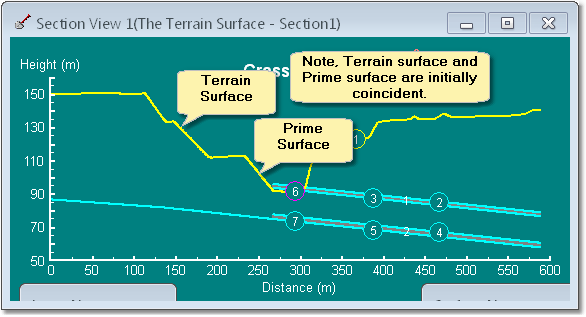
Rehandle, Terrain surface and Prime surface as imported.
As can be seen in the cross-section above, the Terrain surface and the Prime surface are coincident after initial import of data.
If an excavation is performed the excavation is performed on both the Terrain surface and the Prime surface:
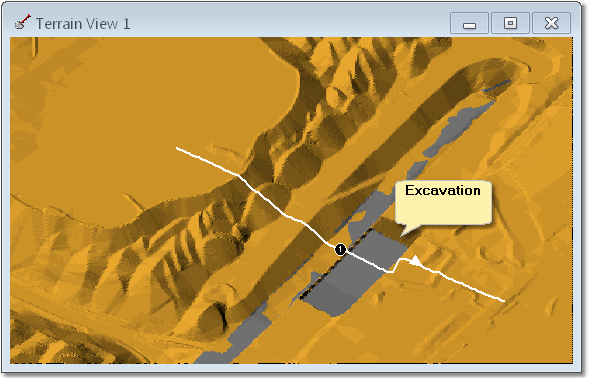
Rehandle - topography after excavation.
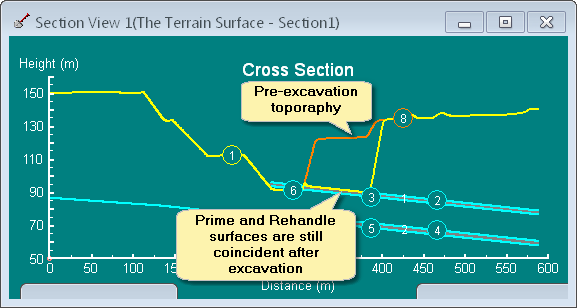
Rehandle - cross section view after excavation.
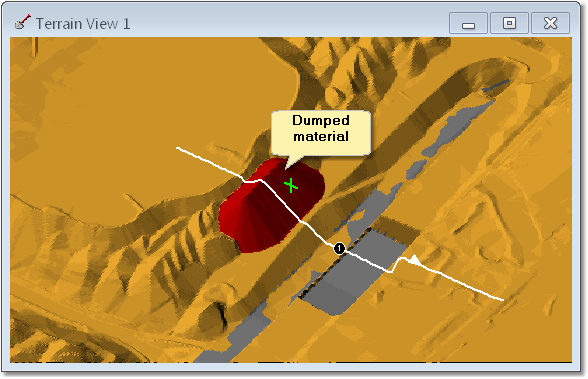
Rehandle - topography after excavation and dumping.
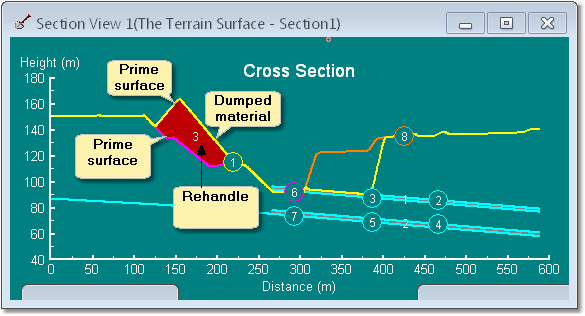
Rehandle - cross section view after dumping.
It can be seen in the above figure that dumped material is placed on the Terrain surface but not on the Prime surface. It can also be seen that the Prime surface follows the as imported topography, which on the low wall side places it on top of the existing spoil. Hence rehandled material which was pre-existing does not appear as rehandle. The following section describes how to mark pre-existing spoil as rehandle.
The above procedure for modelling Prime and Rehandle will work providing all material rehandled by simulation is material is dumped by 3d-DigPlus as part of the simulation. If a particular simulation is proposed to excavate waste material which was represented on the topography when it was imported, this material must be marked as rehandle.
To market material as rehandle select the command Material/Logged Rehandle. This will open up the Mark Rehandle dialog:
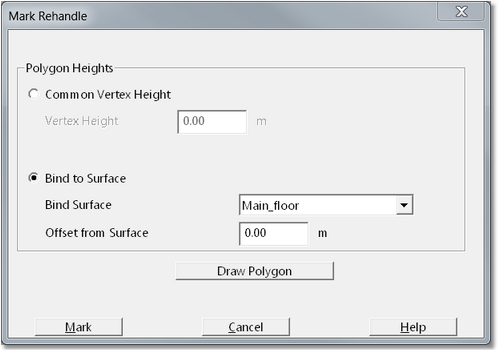
Mark Rehandle dialog.
The process for marking rehandle is very similar to performing an excavation. The user draws a polygon on the topography to delineate the area to be marked as rehandle. Various settings in the Mark Rehandle dialog are used to determine the depth to which the rehandle mark will occur. The system then performs an excavation on the Prime surface to mark the rehandle.
The Mark Rehandle dialog contains the following components:
•Common Vertex Height radio button and Vertex Height field. Selecting this radio button implements the common vertex height method of determining the depth of the rehandle excavation. This method will excavate the Prime surface to a nominated level within the bounds of a user drawn polygon. The desired excavation level is input into the Vertex Height field.
•Bind to Surface radio button and Surface pulldown list. Selecting this radio button implements the Bind to Surface method of determining the depth of the rehandle excavation. The user selects an inner surface from the Bind Surface pulldown list. This method will excavate the Prime surface to the nominated Bind surface within the bounds of a user defined polygon. This method also includes the Offset from Surface parameter. This allows the user to specify an offset from the Bind Surface that will be applied when excavating.
•Draw Polygon button. When the above parameters are selected and edited the user clicks the Draw Polygon button. Focus returns to the Terrain Window where the Terrain Cursor is active. The user draws a polygon by point and left click. When complete the user right clicks and focus returns to the Mark Rehandle dialog.
•Mark button. When the above processes are complete the user clicks the Mark button and the system excavates the Prime surface, within the nominated polygon, to the nominated level or surface and reports the volume excavated.
After performing a Mark Rehandle operation it is strongly recommended that cross-section is drawn through the marked area and the resultant prime surface is checked. The following figures demonstrate the application of the Mark Rehandle method to the design file used for the previous figures.
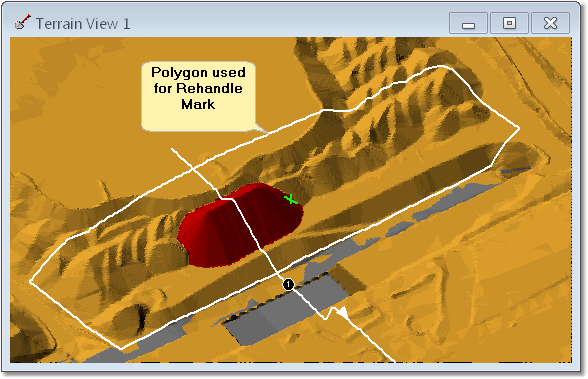
Mark Rehandle example, Mark polygon.
Note that the polygon used for marking Rehandle only needs to cover the region which is likely to be excavated during subsequent simulation.
The option Bind to Surface is used and the floor of the lowest coal seam excavated in the pit is used as the bind surface. This coal seam floor represents the base of all previous excavations in the pit, and therefore represents the interface between in situ and spoil material.
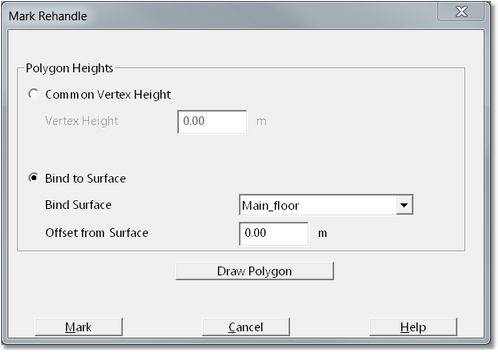
Mark Rehandle settings used four example operation.
The following cross section view shows the results of the Mark Rehandle operation. Note that where the Prime surface is coincident with the Lower Seam Floor surface, the trace line for the Lower Seam Floor surface appears on top of the Prime Surface, however both surfaces are coincident in this area:
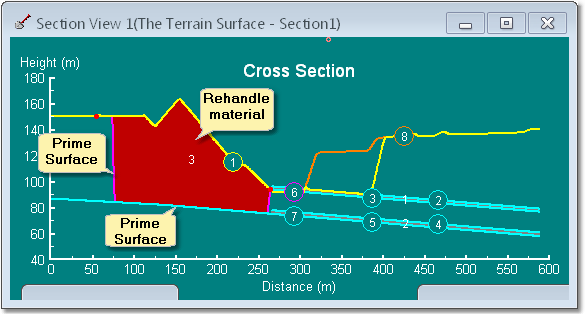
Mark Rehandle - cross section view.